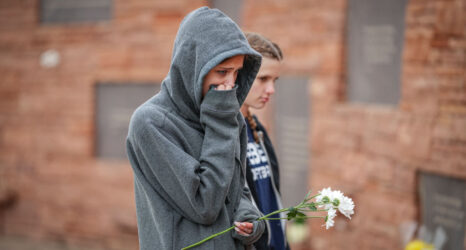“Good Morning America” host Lara Spencer ridiculed Prince George for his love of ballet. ISRO Chairperson Kailasavadivoo Sivan was public criticized for crying when Chandrayaan-2’s Vikram Lander failed to touch down on the Moon’s surface.
These stories took shape in the last month—but they’re part of a bigger and highly visible public discourse about masculinity. What messages are we sending to young men and boys when we reinforce this narrative about what is and is not acceptable? Is it the message we want to be sending as we strive toward a more gender equitable world?

Men cry. Biologically speaking, baby boys and baby girls are “programmed” to cry equally. They cry the same amount at birth. They cry the same amount for the first five years of their life.
Turns out that when you’ve put your blood, sweat, and tears into something that’s been in the works since 2007 — or you see your lander spacecraft lose communication with ground stations just 2.4 kilometers before touching down on the Moon’s surface, crying is a really natural human response.
But according to Tony Porter, “around age 5, boys get the message that anger is acceptable but that they’re not supposed to show other feelings, like vulnerability.” This expectation isn’t nature—it’s constructed by society. And it’s magnified when esteemed political analysts like Gaurav Pandhi vocally and visibly reinforce it.
I’m wondering: What would we have wanted to see? Would we have been more comfortable if Sivan had responded to the failed landing with a gruff handshake and brief statement? Space exploration is resource-intensive, time-intensive and passion-intensive. Probing the edges of the known universe is literally as Earth-shattering as it gets. You don’t enter the field if you’re not passionate about the galaxy’s possibilities. To have the world look on as a mission you are in charge of does not culminate in the outcome you were hoping for must be, at the least , and very likely, heartbreaking.
Men dance. Gay men dance. Straight men dance. Young men dance. Old men dance.
Dance is a way to physically convey the entire spectrum of humanness — from grief to joy to love — with one’s body. It is a sport and and art that requires massive amounts of strength and skill. There is also a rich history of boys and men using dance as a form of resistance against the hurt and pain of harsh social, economic, and political conditions faced by marginalized groups.
When conversations in the mainstream mock young boys from participating in activities like dance, what are we actually saying to boys around the world?
The mockery conveys that using art as an outlet for emotion is “girly” or “gay.” Comments like Spencer’s communicate that girls using ballet as a way to stay active and express themselves is beautiful, but for a young boy, it has to be just a phase — it would be laughable for it to be anything more. It’s actually interesting that Spencer said “we’ll see how long that lasts” about Prince George’s love of dance because she’s pointing to a sad truth of our society. It might be cute for a young boy to do ballet, but with the flack that Prince George is likely to get should he continue doing ballet as he grows up, it might become harder and harder for him to thrive as a male dancer amidst bullying from peers and microaggressions that would be likely to arise about his sexuality and “manliness.”
When we take away yet another tool that boys have to express themselves in a productive and peaceful, we are again reinforcing the norms of toxic masculinity, right from childhood.
Men hurt. The rough exteriors we’ve encouraged our boys to cultivate cover up a depth of pain that can go along with growing up as a boy. While society speaks openly about the obstacles that accompany girls’ success in school, family, and the workplace, we’re nearly silent about the burdens that are borne by boys. And we give them major signaling as they’re growing up that they should remain silent about their pain.
This isn’t discussed enough, but 53 percent of the sexual abuse incidents in India each year are crimes against boys. Boys are less likely to tell a family member about their experiences with abuse. Boys are 89 percent less likely than girls to reach out for psychiatric support after they have been victims of sexual violence. Instead, they might rely on outlets like misbehaving in school or exaggerated visibility — what is actually in many cases a desperate cry for help.
Boys who have been hurt rely, in some cases, on violence as a way to express their pain. When we remove outlets like open expression of emotion or creation of art from the toolkit that boys have to process their pain, we are seriously stunting their ability to live happy, fulfilled lives.
The next time we comment on men displaying their passion and vulnerability in the public sphere, I hope we can take a moment to think about the very real consequences of the judgements we pass.





